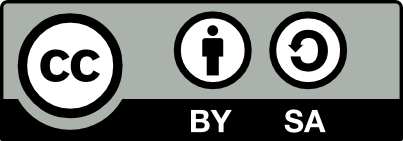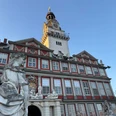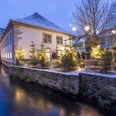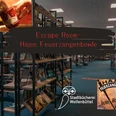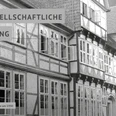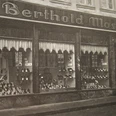"Perhaps you've just come out of a café, done some shopping or are on your way to the train station. This intersection here, on the edge of Wolfenbüttel's city center, is a busy place today - full of life. But it wasn't always like this.
Less than 100 years ago, people walked along here who would soon never return. Their paths led to the concentration camps of Auschwitz and Theresienstadt. Today, the memorial in front of which they stand is a reminder of their fates.
Walk around the memorial. What do you see?
The base plate of the memorial is in the shape of a Star of David, a centuries-old symbol of Judaism. Perhaps you know its meaning: protection, solidarity, but also identity.
And these stelae sticking out of the ground - what could they stand for? Their shape is reminiscent of railroad tracks. They symbolize the transports that led many people from here to the extermination camps.
The Holocaust was the systematic mass murder of around six million Jews between 1941 and 1945. The National Socialists persecuted them and many other minorities, including people with disabilities, Sinti and Roma, political dissidents and homosexuals. Millions of people were murdered in concentration camps such as Auschwitz, Theresienstadt and Dachau - by gas, hunger, disease and brutal forced labor - a crime of unimaginable proportions.
Over 130 Jewish citizens also lived here in Wolfenbüttel. Almost all of them were deported, disenfranchised or murdered.
Lore Adler:
"My name is Lore Adler. In 1942, I was 21 years old and born disabled. Reason enough for the Nazis to send me to Auschwitz. Nobody knows what happened to me."
Alfred Perkamus:
"I am Alfred Perkamus. They stormed my apartment in July 1933, in the middle of the night. Before I could even put my pants on, they had already thrown me down the stairs. They beat me all night long. My lover had to watch it all. I didn't live to see the next morning."
The Jewish families in Wolfenbüttel were forced into so-called 'Jews' houses' - run-down, overcrowded buildings that were often located in streets such as Lange Straße or Karrenführerstraße. There they were isolated, monitored and robbed of their dignity. For many, the journey to the concentration camps began from these houses."
Max Cohn:
"My name is Max Cohn. I lost my arm in the First World War, but that didn't protect me. I was deported to Theresienstadt. I survived - many others didn't."
Fritz Fischer:
"Fritz Fischer is my name. I left the KPD, but that didn't save me. One night they took me out of my apartment. They beat me so badly that I could no longer walk. My intestines were hanging out. My last sentence was a greeting to my sweetheart."
Johanna Cohn:
"I am Johanna Cohn. They deported me and my husband. Nobody knows where. We were never found again."
Each stone and each of the more than 130 names on this memorial in front of which you stand today tells a story. It reminds us not to forget the past. Let us stand together to ensure that discrimination, racism and hatred have no place in our society.
Good to know
Eligibility
for Class
for familys
for individual guests
Pet allowed
for Children of the age of 10 upwards
Payment methods
Contact person
Stadt Wolfenbüttel - Abteilung Tourismus
Author
Lessingstadt Wolfenbüttel
Organization
Lessingstadt Wolfenbüttel
License (master data)
Our recommendations
Nearby

